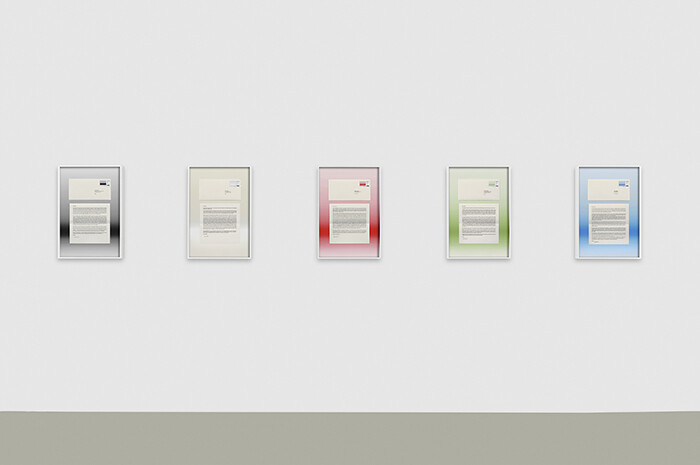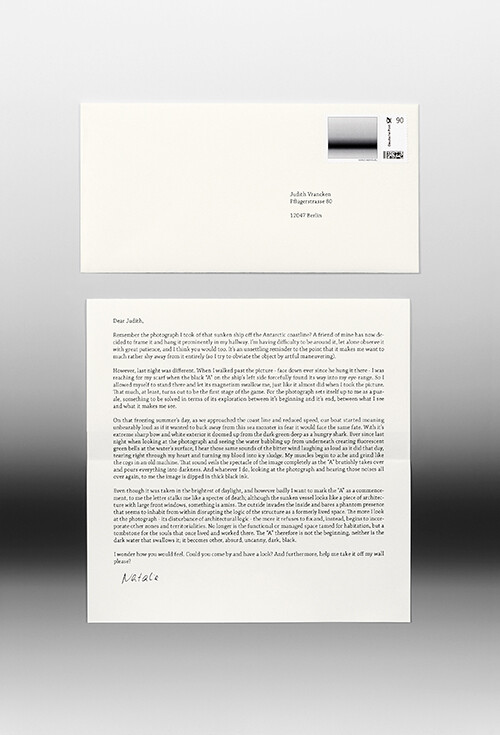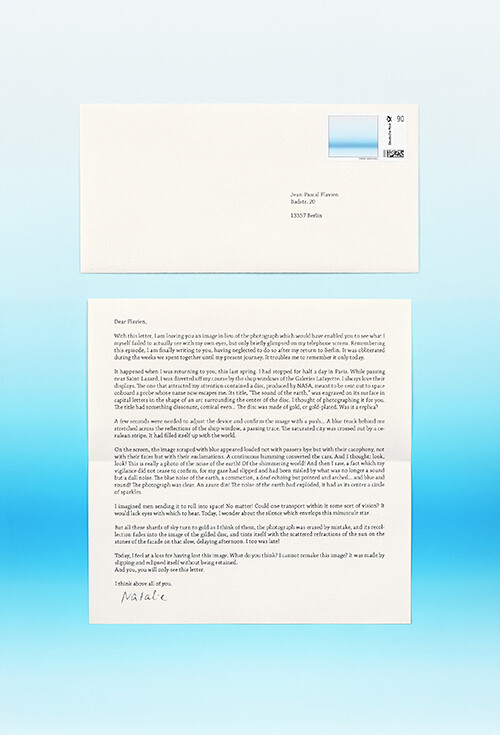Natalie Czech’s first exhibition at Capitain Petzel is an exemplary case of thought rendered in the medium of photography. In her series “Poems by Repetition” and “Voyelles” (both 2013), Czech employs photography as a means of inhabiting a range of artistic literary genres—poetry, journalistic media, lyrics from popular music, and epistolary writing. Reaching beyond the modernist idea of a given genre’s imperative to immanent progress, she creates photographic works that are derived from text-based sources, and simultaneously diverge from strict photographic formalisms. The exhibition’s title, “I Cannot Repeat What I Hear,” stresses the visual embodiment of language against its audible forms.
Voyelles I and II (2013), shown in the upper gallery, each consist of five works. Here, Czech seems to test out a transfer of written synaesthesia into photography. The series title is taken from Arthur Rimbaud’s 1871 sonnet, which begins with the line: “A noir, E blanc, I rouge, U vert, O bleu: voyelles.” Assigning a color to each vowel, Rimbaud ferociously spelled out seen, felt, and lived intensities in the poem, expanding on those five synaesthetic modalities in its subsequent lines. Czech asked ten different authors, poets, curators, and artists to each write a one-page letter to themselves in her name. Using one of Rimbaud’s vowel/color combinations as a starting point, they each narrated a synaesthetic experience arising from a photograph. Then, setting the letters and envelopes (displaying its author’s full name and address) against a background of their respective colors, Czech photographs and frames them, aligning them on the wall in rows of five. Assuming authorship of the work by way of multi-leveled acts of appropriation, she frees the figural image from the burden of representation, reinventing debates that surrounded photography in the late 1970s. Rimbaud’s sonnet thus becomes photographic, appropriated on the level of the producers (writers), the mediator (artist), and the perceivers (us).
In her “Poems by Repetition” series located in the gallery’s main space, Czech uses LP record sleeves, magazine articles, instruction manuals, and dictionary entries—or more precisely, the letters imprinted on them—as raw material for the creation of poetic sequences displayed across thirteen groups of framed color photographs. Within these easily identifiable texts from popular culture, Czech parses out the poems of Bruce Andrews, Gregory Corso, Hart Crane, Robert Creeley, Allen Ginsberg, Bruce Hainley, Yunte Huang, Aram Saroyan, Gertrude Stein, and Emmett Williams by eliminating all extraneous words, so that only the poem remains. However, because these texts are enlarged in photographs, they no longer conform to the medium of its delivery in the way that we experience them in everyday life—as pages of a book, LP liner notes, iPad interfaces, and words on Kindle screens—but rather as a photographic copy.
Czech cites Stein’s 1922 “Saints and Singing” poem, in which repetition is staged as a means of expression and construction, as a key frame of reference for this series. Taking this hint a bit further, one might also think of Stein’s other works, like “Portraits and Repetitions” (1926), in which repetition is differentiated from insistence, or her 1926 novel The Making of Americans: Being a History of a Family’s Progress, in which repetition characterizes love. One could also trace threads beyond purely literary forms, like Gilles Deleuze’s 1968 Difference and Repetition, in which repetition returns as a form of transgression. Photography, as presented here, becomes the perfect medium for exploring such repetitions.
Take, for example, works like A poem by repetition by Emmett Williams, which are made up of multiple images, each highlighting a single line of text. In this case, a photograph of an overdrive pedal for the electric guitar—imprinted with its “American Woman” logo—is elongated across three distipnctly framed, stacked images. The equipment’s logo is repeated three times: the top image almost entirely shows the mint green pedal with its logo against a white background, the middle one only repeats the section with the logo, and the bottom one displays the logo and the pedal’s lower edge. With each photographic repetition, the pre-existing text is modified (though, as in all of Czech’s works in the series, the concealed text remains partially legible) so that only the letters constituting Williams’s poem remain: “A Man. A Woman. Amen.”
In a similar vein, A poem by repetition by Allen Ginsberg features three different views of a page from Border Crossings, a Canadian magazine in which the triptych Untitled (3 Erics) (1981) from Robert Longo’s famous “Men in the Cities” series is typeset alongside an interview with the artist. From left to right, Czech’s panels progressively magnify the page. The first is a photograph of the entire page, the second is a close-up of its right half, and the third is an even more extreme close-up of its left half. None of the photographs actually reproduce the magazine in its original size—the last frame is the largest (140 x 33 cm), and the first the smallest (114 x 87 cm); however, the only element that seems to determine the scale of the photographs here—which can be said about all the works in the “Poems by Repetition” series—is Ginsberg’s poem. Czech has masked-out all of the interview’s text in a darker shade of white, except for the letters constituting Ginsberg’s lines, which are dispersed across all three panels (one sentence per frame): “I made love to myself in the mirror kissing my own lips. Saying I love myself. I love you more than anything.” The images are sharp in visual detail—a graphic specificity that even expands to the way that the works are framed, which is apparently of great importance to the artist. In this instance, a narrow black frame harmonizes with Longo’s black-and-white drawings of the contorted figures.
Significantly, Longo’s study of this tragically convulsive body for his “Men in the Cities” series—inspired by the gestural movement of a dying man in Rainer Werner Fassbinder’s 1970 film The American Soldier—first appeared as a cast aluminum relief in art historian Douglas Crimp’s now famous 1977 “Pictures” group exhibition at Artists Space in New York. What Crimp argued in the exhibition’s catalog is that the photographic medium, which had long been relegated to the margins of visual representation, was newly emancipated, returning as discrete realities and materialities. It is as if Czech has taken this position—that photography has a materiality of its own—as her own starting point in these works. And she appropriates poetry as a possible representation of it.









